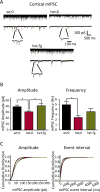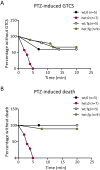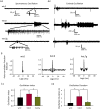Overexpressing wild-type γ2 subunits rescued the seizure phenotype in Gabrg2+/Q390X Dravet syndrome mice
- PMID: 28586508
- PMCID: PMC5554098
- DOI: 10.1111/epi.13810
Overexpressing wild-type γ2 subunits rescued the seizure phenotype in Gabrg2+/Q390X Dravet syndrome mice
Abstract
Objective: The mutant γ-aminobutyric acid type A (GABAA ) receptor γ2(Q390X) subunit (Q351X in the mature peptide) has been associated with the epileptic encephalopathy, Dravet syndrome, and the epilepsy syndrome genetic epilepsy with febrile seizures plus (GEFS+). The mutation generates a premature stop codon that results in translation of a stable truncated and misfolded γ2 subunit that accumulates in neurons, forms intracellular aggregates, disrupts incorporation of γ2 subunits into GABAA receptors, and affects trafficking of partnering α and β subunits. Heterozygous Gabrg2+/Q390X knock-in (KI) mice had reduced cortical inhibition, spike wave discharges on electroencephalography (EEG), a lower seizure threshold to the convulsant drug pentylenetetrazol (PTZ), and spontaneous generalized tonic-clonic seizures. In this proof-of-principal study, we attempted to rescue these deficits in KI mice using a γ2 subunit gene (GABRG2) replacement therapy.
Methods: We introduced the GABRG2 allele by crossing Gabrg2+/Q390X KI mice with bacterial artificial chromosome (BAC) transgenic mice overexpressing HA (hemagglutinin)-tagged human γ2HA subunits, and compared GABAA receptor subunit expression by Western blot and immunohistochemical staining, seizure threshold by monitoring mouse behavior after PTZ-injection, and thalamocortical inhibition and network oscillation by slice recording.
Results: Compared to KI mice, adult mice carrying both mutant allele and transgene had increased wild-type γ2 and partnering α1 and β2/3 subunits, increased miniature inhibitory postsynaptic current (mIPSC) amplitudes recorded from layer VI cortical neurons, reduced thalamocortical network oscillations, and higher PTZ seizure threshold.
Significance: Based on these results we suggest that seizures in a genetic epilepsy syndrome caused by epilepsy mutant γ2(Q390X) subunits with dominant negative effects could be rescued potentially by overexpression of wild-type γ2 subunits.
Keywords: Dravet syndrome; Epileptic encephalopathy; GABAA receptors; GABRG2(Q390X) mutation; Gene-replacement therapy; Genetic epilepsies.
Wiley Periodicals, Inc. © 2017 International League Against Epilepsy.
Conflict of interest statement
The authors have no potential conflicts of interest to disclosure.
Figures





Similar articles
-
GABRG2 mutations in genetic epilepsy with febrile seizures plus: structure, roles, and molecular genetics.J Transl Med. 2024 Aug 14;22(1):767. doi: 10.1186/s12967-024-05387-1. J Transl Med. 2024. PMID: 39143639 Free PMC article. Review.
-
4-Phenylbutyrate promoted wild-type γ-aminobutyric acid type A receptor trafficking, reduced endoplasmic reticulum stress, and mitigated seizures in Gabrg2+/Q390X mice associated with Dravet syndrome.Epilepsia. 2024 Jan;65(1):204-217. doi: 10.1111/epi.17779. Epub 2023 Nov 29. Epilepsia. 2024. PMID: 37746768 Free PMC article.
-
Altered GABAA receptor expression in brainstem nuclei and SUDEP in Gabrg2(+/Q390X) mice associated with epileptic encephalopathy.Epilepsy Res. 2016 Jul;123:50-4. doi: 10.1016/j.eplepsyres.2016.04.002. Epub 2016 Apr 13. Epilepsy Res. 2016. PMID: 27131289 Free PMC article.
-
Heat induced temperature dysregulation and seizures in Dravet Syndrome/GEFS+ Gabrg2+/Q390X mice.Epilepsy Res. 2017 Aug;134:1-8. doi: 10.1016/j.eplepsyres.2017.04.020. Epub 2017 Apr 30. Epilepsy Res. 2017. PMID: 28505490 Free PMC article.
-
Molecular Pathogenic Basis for GABRG2 Mutations Associated With a Spectrum of Epilepsy Syndromes, From Generalized Absence Epilepsy to Dravet Syndrome.JAMA Neurol. 2016 Aug 1;73(8):1009-16. doi: 10.1001/jamaneurol.2016.0449. JAMA Neurol. 2016. PMID: 27367160 Free PMC article. Review.
Cited by
-
Haploinsufficiency, Dominant Negative, and Gain-of-Function Mechanisms in Epilepsy: Matching Therapeutic Approach to the Pathophysiology.Neurotherapeutics. 2021 Jul;18(3):1500-1514. doi: 10.1007/s13311-021-01137-z. Epub 2021 Oct 14. Neurotherapeutics. 2021. PMID: 34648141 Free PMC article. Review.
-
GABRG2 mutations in genetic epilepsy with febrile seizures plus: structure, roles, and molecular genetics.J Transl Med. 2024 Aug 14;22(1):767. doi: 10.1186/s12967-024-05387-1. J Transl Med. 2024. PMID: 39143639 Free PMC article. Review.
-
You Snooze You Seize: GABAergic Potentiation of Genetic Generalized Seizures During NREM.Epilepsy Curr. 2021 May 6;21(4):290-292. doi: 10.1177/15357597211012454. eCollection 2021 Jul-Aug. Epilepsy Curr. 2021. PMID: 34690570 Free PMC article. No abstract available.
-
4-Phenylbutyrate restored γ-aminobutyric acid uptake and reduced seizures in SLC6A1 patient variant-bearing cell and mouse models.Brain Commun. 2022 Jun 6;4(3):fcac144. doi: 10.1093/braincomms/fcac144. eCollection 2022. Brain Commun. 2022. PMID: 35911425 Free PMC article.
-
Long-Term Fish Oil Supplementation Attenuates Spike Wave Discharges in the Amygdala of Adult Rats with Early-Life Febrile Seizures.Brain Sci. 2025 Apr 14;15(4):395. doi: 10.3390/brainsci15040395. Brain Sci. 2025. PMID: 40309871 Free PMC article.
References
-
- England MJ, Liverman CT, Schultz AM, et al. Epilepsy Across the Spectrum: Promoting Health and Understanding. National Academies Press (US); Washington DC: 2012. - PubMed
-
- MacDonald B. The prognosis of epilepsy. Seizure. 2001;10:347–358. - PubMed
-
- Schmidt D, Sillanpaa M. Evidence-based review on the natural history of the epilepsies. Curr Opin Neurol. 2012;25:159–163. - PubMed
-
- Thomas EA, Petrou S. Network-specific mechanisms may explain the paradoxical effects of carbamazepine and phenytoin. Epilepsia. 2013;54:1195–1202. - PubMed
Publication types
MeSH terms
Substances
Grants and funding
LinkOut - more resources
Full Text Sources
Other Literature Sources

